Tomb Raider Review
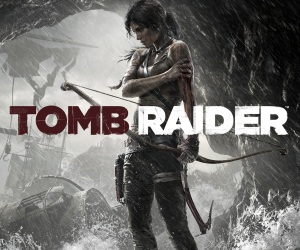 Game: Tomb Raider
Game: Tomb Raider
Developer: Crystal Dynamics
Publisher: Square Enix
Available On: Xbox 360, PlayStation 3, Windows PC
Reviewed On: Xbox 360
The Queen song “Under Pressure” must have been metaphorically reverberating around the halls of Crystal Dynamics’ studio for the entire development period of Tomb Raider. Not only is it the reboot of a massively popular franchise, but it’s also an origin story – which is bit of a twofer for the people who are attached to Lara of old – so this new title really has to excel at everything it does to get everyone board. Luckily, then, it’s an absolutely stunner.
STORY: As an origin story, Tomb Raider introduces us to Lara Croft, a young, bright and beautiful woman. There’s no ignoring it, new Lara has been designed to appear spellbindingly pretty, but, at the same time, she’s of the age where most of the men around her are more like father figures. Indeed, some of the characters knew Lara’s father, and this Lara is polite, respectful and absolutely full of character and courage. Bloody good thing, too, as she is very quickly forced into life or death situations, with her ship and crew thrown into peril as a storm causes them to crash and find themselves on an island full of hostile foes. As crashing waves lash the shores, Lara must find her friends and also uncover the mystery of the island she came to discover. You could almost fall foul of thinking that the developers hate Lara Croft, the amount of pain and discomfort she has to endure early on. She gets stabbed and shot at, forced to traverse areas full of festering corpses – in fact, it’s pretty grim and dark for most of the time.
Early on, the developers completely succeed in making Lara a living, breathing person, but as she gains experience (more on this later) she becomes less an untrained youth and more a massively skilful warrior. It may be a case of wanting our cake and eating it, but like every other developer out there, Crystal Dynamics struggle to explain quite how a naïve innocent becomes a killer so quickly, slaughtering masses of enemies with little hesitation. There’s an early attempt at rationalising it (as Lara explains she had to kill to protect herself and found it surprisingly easy) but it’s not enough to warrant, nor explain away, the Nathan Drake-style mass-slaughter that follows. On top of that, Lara is just about the only character you’ll care about. It’s not the end of the world that some of the personalities on show are generic and clichéd, but it’s a shame nonetheless.
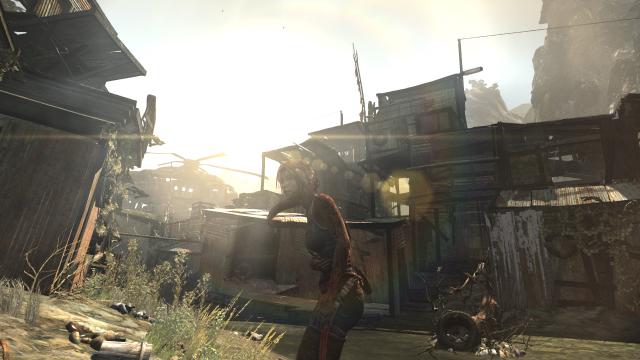
GRAPHICS: From craggy cliffs to gorgeous panoramic views, with plenty of jungle exploration and dank, dark tombs, the attention to detail is commendable. Simple things like Lara’s reaction to pain help immersion greatly, but the fact that a wounded deer will visibly limp away to safety is fantastic and just helps the player embrace everything they are seeing. There are odd anomalies though, like how the bow will vanish from sight when using a gun, only to magically reappear when equipped.
Little niggles aside, it truly is a remarkable looking game and the island is full of wildlife to hunt, which helps to bring the environment to life even further. The only really negative thing you can say about it is that the PC version will look even better.
SOUND: As Lara is in pain, she will breath heavily. Again, it’s a simple touch that makes sense when you think about it, but hearing it in action reminds the player that Lara isn’t some cartoon character; she’s real. Musical stings are appropriately used to good effect, but Lara herself truly is the star of the game. Her voice acting superb, a young person lost in a situation she has no control over. Lara will often utter to herself “You can do this”, a mantra which is used throughout the game to push the player forward; you can do this.
Different English accents are used, along with American ones too. Brilliantly, the different accents are remarked upon at one stage, as though Crystal Dynamics want you to see how much effort has been put into the audio – which makes it even more of a shame that the personalities are a bit generic.
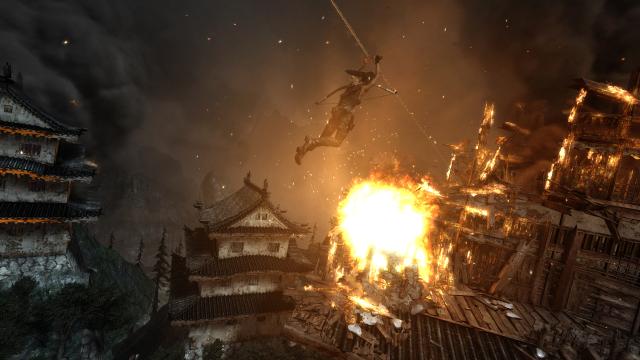
GAMEPLAY: Tomb Raider is a third person shooter with platform elements, but there’s so much thrown into the experience that it’s hard to know where to begin. Lara controls exceptionally well, the controls are responsive and at no point will you struggle with camera angles, no matter what you’re doing. The aiming is great, whatever weapon you’re using and there’s even stealth elements in the game, should you so fancy that option. The enemy AI is pretty smart though, which is a welcome surprise. They won’t just let you pick them off from a distance; once they’ve spotted you they will attempt to flush you out of cover, and they aren’t messing about either. Immediately upon seeing you, a rain of fire will fall upon your location, forcing you to move or die. Instead of a roll or evade button, hitting “B” will make Lara scramble along the floor, attempting to dodge gunfire until she finds cover – there’s no button for going into cover, either, and Lara will just use it when it appears (like a handy wall, for instance). It’s exciting, fluid and very, very enjoyable.
At base camps along the journey you can upgrade various additional mechanics, such as your gear (guns and the bow have secondary attacks which are incredibly useful) via salvage you can find in lock boxes. On top of that, you can use skill points gained through XP (which you earn exactly as you’d think) to upgrade things like how strong your bow and arrow shots are, or how much salvage you find when you loot a corpse or box. It’s all quite game-y, but somehow it doesn’t break the immersion. Something that does harm things slightly, however, is how busy the screen can be at times. Whatever you are doing, the XP bonus will constantly ping on the top left of the screen. It’s not horribly intrusive but it’s an odd decision in an experience that is otherwise so engaging. The upgrade sections are fairly menu-heavy too, with large bulky visuals that require a lot of navigation littering the screen during these moments – with yet another screen appearing to tell you that you unlock something, right after pressing the button to unlock it.
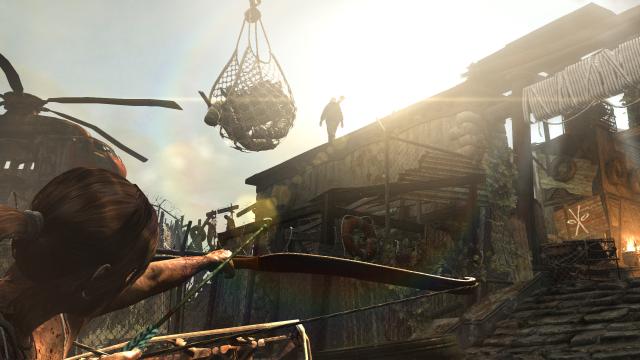
They really have thrown everything into the game though, and the addition of fast-travel (camp to camp, once found) means that there are plenty of collectibles to search for, and even players who tend to mainline a story campaign will go back for more. In fact, clever game design means that as you progress through the story, you’ll find new tools that will allow access to locations from earlier in the game. It adds up to a huge package, but it’s almost too much. There are so many collectibles that they become a distraction at times, and coupled with the amount of messages about concept art, or this, that or the other being unlocked, immersion takes an unnecessary hit. To help you find all of these items, Lara has the ability (with the press of the Left Bumper) to hone in using her instincts. This isn’t Batman’s detective vision, it’s a short sharp burst of black and white visuals, with interactive objects highlighted in a glowing yellow hue.
Quick-time events make an appearance in Tomb Raider, and are just about the only bugbear I have with the gameplay overall. The method of displaying which buttons you need to push isn’t anything new, a circle will appear and as it decreases, the corresponding button will appear. However, they require quite swift reactions, and you’ll fail quite a lot before you realise that more often than not, it’s a press of “Y” that’s required. It’s a minor flaw, but it is something that’ll make you see that loading screen a few times early on in the game.
Puzzle elements are mostly optional side quests, or tombs. These are a fun distraction, starting out easily and getting harder, but the puzzles (on the whole) become more prevalent as you progress. It’s during these puzzles and less combat-heavy moments that Tomb Raider really shines. The platforming is ace, as is the feeling you get when you find the tomb’s end and are rewarded with a trinket for getting there. Each area is fairly linear, so don’t expect an enormous Far Cry style island to explore. When the areas do widen though, to allow you to explore for collectibles or choose your own path to the enemy, it’s a joy – and once again better than being funnelled down a path, taking enemies out as you go.
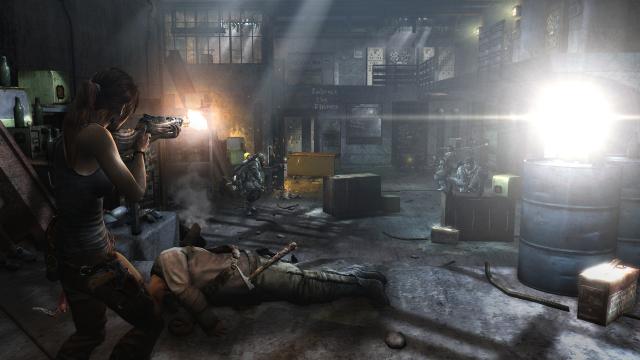
MULTIPLAYER: As is the norm for almost every game nowadays, Tomb Raider has a full multiplayer mode, with multiple modes. Free for All is exactly as it sounds, but with a twist, while Cry for Help is a mode where teams must face-off and protect their batteries whilst activating radio antennas. Team Deathmatch is present too, and the fourth mode is “Rescue”, which has one team try to recover medical supplies, whilst the opposite team has to finish them off with a melee attack. When carrying the objects, team-work is a must as you can’t fire or jump without losing it.
Some of the controls change slightly, and a short-burst sprint button is introduced, so it does change things up slightly. Of course, all the bells and whistles are present including levelling up, loadouts, perks and challenges, but how much you’ll play the multiplayer depends on entirely how much fun you have with it. The game mechanics are the same, which means multiplayer matches are fast and fluid. Overall it’s an enjoyable addition, but it’s not going to be hurting Call of Duty’s player-count any time soon, especially with only five maps to play.
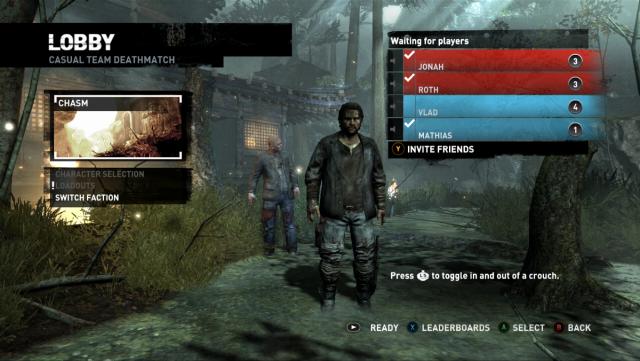
LONGEVITY: Tomb Raider is a surprisingly long game. Even when you think you’re approaching the end-game, there’s more to explore and enjoy. In a lot of games this might even be frustrating, but such is the fun you’ll have just playing Tomb Raider, you’re almost relieved it’s not over yet. A first playthrough will take roughly 15 hours, but if you go out of your way to explore the island for all the collectibles (and again, there’s a lot of them) you could potentially get nearer 25 hours or more. Throw in the multiplayer option, and Tomb Raider adds up to be great value for money.
VERDICT: Risk be damned, Crystal Dynamics have succeeded in making a superb game. There are definite moments where the mantra “less is more” would have been better used than the kitchen sink approach, but throughout Tomb Raider there are wow moments that make you realise why you love playing games, and for a change, they aren’t just relegated to stunning visual effects.
Tomb Raider reminds us all why we love Lara, and how good a video game can be. Fantastically addictive, compelling and enjoyable to play throughout, this new Tomb Raider is a game you absolutely must own, as it’s easily one of the best games so far this year.





